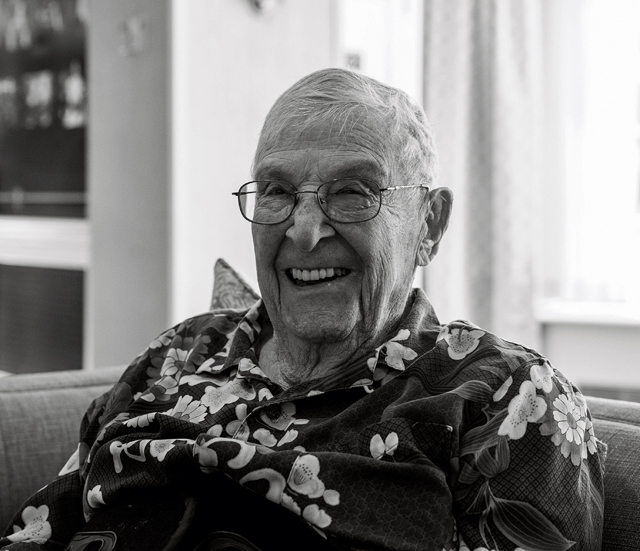
“Hours of boredom punctuated by moments of sheer panic,” is how retired Col. Richard Heyman described his experience as a pilot during World War II, the Korean War and the Vietnam War.
Growing up in Bartlesville, Oklahoma, Heyman’s fascination with flight took hold as he watched British pilots train at Spartan Field in Miami, Oklahoma, during WWII. Driving past the airfield, he was mesmerized by aircraft performing aerial maneuvers, especially the iconic P-38 Lightning.
The decision to enlist and be a pilot became clear. “That’s the life, that’s what I want to do,” then the young Heyman thought.
Heyman’s father signed his enlistment papers on the condition that he graduate from high school first. True to his word, the day after graduation, Heyman embarked on a lifelong aviation career.
In 1943, at 19, he completed pilot training and was commissioned as a second lieutenant in the U.S. Army Air Forces.
“I wanted to fly, and I got my wish,” Heyman reminisced.
Mirroring his own fledging career — his first assignment was with the newly christened Eighth Army Air Force. It would be the beginning of a journey that would take him across continents and decades of service.
By 1944, the young pilot found himself in the United Kingdom at the center of WWII, tasked with escorting bombers on long-range missions into enemy territory, ensuring they reached their targets and returned safely.
“The [Nazis] didn’t take kindly to us,” he said. “We did our job. We were there to make sure those bombers made it home.”
Flying the P-38, affectionately known as the “Twin-Tailed Devil” by German pilots, Heyman was always ready for the challenge, adding that in many cases the deciding factor in a dogfight came down to who could outmaneuver the other.
“There were moments of sheer terror,” Heyman described. “But, when you’re in the cockpit, there’s no room for fear. You focus on the mission — on getting home in one piece. That’s what mattered.”
As the war in Europe raged on, Heyman became one of his squadron’s youngest and most experienced fighter pilots. His love for flying and his confidence in the air would serve him well in the future.
For his efforts and contributions during WWII, Heyman was honored with the 2024 Swords of Honor at the Royal Air Force Museum American Foundation “Spirit of the Battle of Britain” banquet marking the 80th anniversary of D-Day held in Washington, D.C. in October.
After WWII, Heyman briefly returned to civilian life, running a small scrap yard business and flying on weekends as part of the Air Force Reserves. However, his flying career wasn’t over.
With the onset of the Korean War in 1950, Heyman was recalled to active duty. This time, his mission would take a different tone — flying night bombing runs over North Korea in the A-26 Invader, a twin-engine light bomber.
During the Korean War, Heyman would add to his legacy by downing an enemy Po-2 biplane, also known as “Bed Check Charlie,” which harassed U.S. troops by dropping hand grenades and small bombs.
“I got a call one night asking if anyone had ammunition left,” Heyman said while describing how he tracked and shot down the elusive aircraft. “I did, so I went after him.”
Hayman reflected with respect on the pilot’s commitment while flying a canvas-covered airplane at 100 miles an hour against the more advanced American forces.
“He had to be the bravest guy in the world,” he said.
When the Vietnam War escalated in the 1960s, Heyman was no longer the young fighter pilot he had been in WWII but a seasoned veteran and squadron commander, leading Airmen into battle.
“Vietnam was a different kind of war,” Heyman recalled. “We flew in formations, sometimes looking for enemy aircraft, but often just looking for targets — anything to slow them down.”
In Vietnam, Heyman flew various missions and aircraft from close air support to strategic bombing. Despite the heavy command responsibilities, Heyman flew combat missions himself, never asking his men to do anything he wouldn’t do.
“You lead by example,” he said. “If you’re in the air, you’re part of the team, no matter your rank.”
After Vietnam, Heyman retired from the Air Force in the early 1970s, serving 32 years in active duty and five years in the Reserves with a myriad of awards including a Silver Star, four Distinguished Flying Crosses and 14 Air Medals. Looking back on his career, Heyman remains humble, brushing off any talk of heroism, preferring to credit the men he flew with.
“I was lucky,” he said. “I had a job to do, and I did it. There were hundreds of guys just like me. We were all part of the same team.”
His service, however, speaks for itself. Few pilots can claim to have flown in three wars, let alone as both a fighter pilot and a squadron commander. Even fewer can say they survived them all.
“You get a certain amount of joy from doing your job well,” he admitted. “But there were a lot of scary moments too. You never forget the people you flew with or the missions you completed. It stays with you.”
As one of the last surviving veterans of WWII, the Korean War and the Vietnam War, Heyman’s story is more than just a tale of military service. It’s a story of resilience, dedication and the unbreakable bond between a pilot and the sky.


